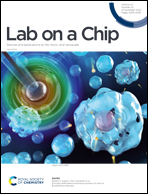Viscosity-aided electromechanical poration of cells for transfecting molecules†
Abstract
Cell poration technologies offer opportunities not only to understand the activities of biological molecules but also to investigate genetic manipulation possibilities. Unfortunately, transferring large molecules that can carry huge genomic information is challenging. Here, we demonstrate electromechanical poration using a core–shell-structured microbubble generator, consisting of a fine microelectrode covered with a dielectric material. By introducing a microcavity at its tip, we could concentrate the electrical field with the application of electric pulses and generate microbubbles for electromechanical stimulation of cells. Specifically, the technology enables transfection with molecules that are thousands of kDa even into osteoblasts and Chlamydomonas, which are generally considered to be difficult to inject. Notably, we found that the transfection efficiency can be enhanced by adjusting the viscosity of the cell suspension, which was presumably achieved by remodeling of the membrane cytoskeleton. The applicability of the approach to a variety of cell types opens up numerous emerging gene engineering applications.



 Please wait while we load your content...
Please wait while we load your content...